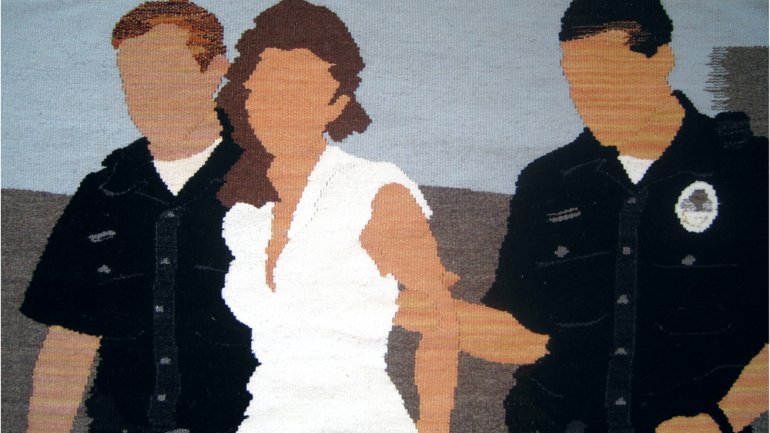Looming Change
Looming Change
Erin M. Riley doesn't want to hear about what can't be woven.
Erin M. Riley wants to get better at bruises. Standing in her studio in Brooklyn, surrounded by tapestries showing women in various states of undress, the 30-year-old weaver is discussing future projects. “I’ve done a few pieces that involve bruising, which is something I want to explore – aggressive sexual behavior,” she explains.
“I haven’t yet because it’s challenging emotionally – and also technically, with the color blending. Bruises are so weird and layered.”
For more than seven years, Riley has explored such themes through her work – the intimate and the intense, with images of drug use and car wrecks, selfies of semi-nude women and, lately, more sexually explicit scenes, all plucked from the internet and reinterpreted on the loom. Her tapestries have been recognized – she has been selected for seven residencies – even if they haven’t always been well received, particularly by the weaving establishment.
“I got a lot of pushback in the beginning,” Riley recalls. “It was an argument that ‘This shouldn’t be woven.’ ”
However transgressive Riley’s subject matter appears, her decision to weave is rooted in a familial sort of pragmatism. “My mom is a mail lady, my stepdad paints cars,” she says. “They do things.” So when Riley left her hometown on Cape Cod to attend Massachusetts College of Art and Design, the idea of specializing in a medium that could double as a trade was appealing. “Doing something like painting,” she reflects, “seemed too frivolous.”
Then, during her studies, Riley began hearing about issues back home – serious problems family members were having with addiction. It prompted her to begin weaving images of her family with certain people highlighted or omitted. As a graduate student at Tyler School of Art in Philadelphia, Riley continued mining her life for inspiration and began incorporating imagery she found online. Tapestries depicting car accidents were metaphors for her absent biological father; seeing a porn star’s selfie on Twitter, coupled with self-reflection, led to Daddy Issues, a series about “girls behaving badly,” and then, ultimately, to the provocative selfies that have become her stock in trade.
Attention predictably followed. Shortly after earning her MFA in 2009, Riley won Best in Show at “Radius 250,” a biennial juried regional exhibition in Richmond, Virginia; in 2011, she was a finalist for the Leap Award given by the Society for Contemporary Craft in Pittsburgh. But she also had to navigate criticism from an unexpected corner. “When I graduated, I thought, ‘I’m going to be in the American Tapestry Alliance. I love weaving, so they’re going to love me,’ ” Riley says. “But I wasn’t supported.”
She remembers doing a show in Australia – and then finding a Facebook thread from an Australian tapestry group bashing her work. The emerging artist made a conscious choice to take a step back from social media and the weaving community.
As Riley’s profile has grown, other detractors have emerged. There were cries that by using found images of semi-naked women, Riley had no skin in the game. Her response was to weave a series of self-portraits. More recent criticism that she depicts only young, thin, white women, however, has proven more complicated to address.
“People say I’m racist or bodyshaming,” Riley says. But, especially early on, she was set on presenting images she could relate to – “using others’ images as self-portraits,” she explains. She didn’t intend to exclude anybody, only to be true to her voice: “Art isn’t impactful if you don’t own the content.” Now, as she is growing older – and more comfortable with her own changing body – Riley sees her voice evolving, too.
That discourse with critics, while frustrating, reflects the degree to which Riley is engaging viewers. “She’s taking online images, which are about the public and culture, and infusing them into what’s traditionally been a domesticated process devoid of content, or any criticism or deconstruction or relationship with culture,” says Cathleen Lewis, vice president of education and programs at the Museum of Arts and Design in New York, where Riley had a residency last fall.
“She’s taking the new and the old, and making them deal with each other in an interesting way. When some people do that, they muck it up. Erin straddles those two worlds well.”
The weaving community may be starting to realize that, too. Recently, Riley says, American Tapestry Alliance members have begun visiting her studio and “are being more supportive,” she says. “They see young weavers looking up to me and realize I could be an entry point.”
If so, perhaps the best lesson aspiring weavers can take from Riley is to do the same thing as the women in her tapestries: Look in the mirror, and capture what they see.
Neil Janowitz is editorial director of vulture.com, New York Magazine’s culture and entertainment site.




